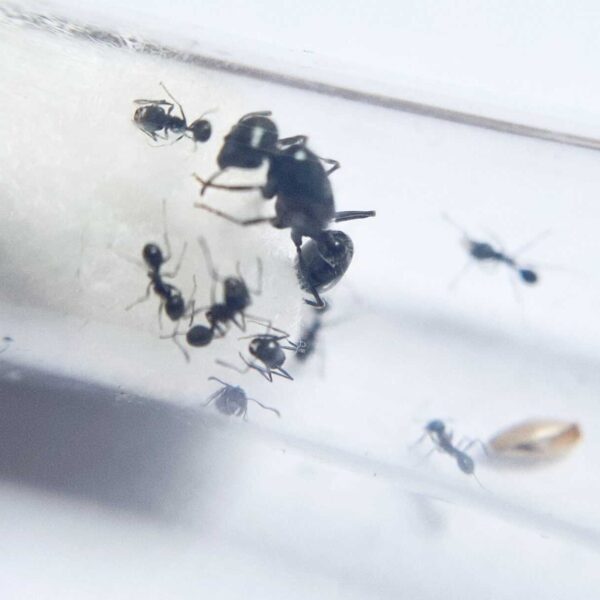-40%
Camponotus laevigatus: Large Gloss Black Ants from the USA
Welcome to our product page for Camponotus laevigatus, also known as large gloss black ants from the USA. This species of ants is monogynous, meaning they have a single queen in each colony. If you are looking to start your own colony, read on to learn more about the size, development speed, nutrition, humidity, temperature, and recommended nests for breeding.
Size and Color
Camponotus laevigatus ants range in size from 14mm to 17mm for the queen, 5mm to 9mm for the workers, and 8mm to 16mm for the majors. These ants have a glossy black color, adding to their aesthetic appeal.
Nutrition for Camponotus laevigatus
When it comes to feeding your Camponotus laevigatus colony, it’s important to provide them with a varied diet to ensure their health and wellbeing. Here are some recommended food sources:
- Insect food (Cockroaches, Crickets)
- Syrup (Water/Honey with Water in ratios of 4:1, 3:1, or 2:1)
- Fruit
- Vegetables
- Jelly
- Cooked Chicken without Salt
By incorporating these food sources into their diet, you can ensure that your Camponotus laevigatus ants receive the necessary nutrients for their growth and development.
Humidity and Temperature Guidelines
Creating the right environment for your Camponotus laevigatus colony is crucial for their overall health and thriving. Here are some guidelines for humidity and temperature:
- Humidity: Camponotus laevigatus ants prefer a humidity level of around 50-60%. To maintain the required humidity, **regularly mist** the nest and surrounding area with water. It’s essential to monitor the humidity levels using a hygrometer and make adjustments accordingly.
- Temperature: These ants thrive in temperatures ranging from 22-26 degrees Celsius (72-79 degrees Fahrenheit). It’s important to keep them away from direct sunlight and drafts that can cause sudden temperature changes. **Using a heating mat or lamp** can help maintain a stable temperature.
Developing Your Camponotus laevigatus Colony
When starting your own Camponotus laevigatus colony, it’s important to provide them with the right conditions to ensure successful reproduction and growth. Here are some tips:
- Choosing the Right Nest: Camponotus laevigatus ants prefer nests with multiple chambers and a combination of humidity and temperature control mechanisms. **Consider using a formicarium** made of acrylic or glass with easy access to food and water.
- Colony Setup: Introduce the queen to the nest and provide her with a small group of workers. Ensure they have sufficient food and water sources, and monitor the colony regularly for growth and expansion.
- Feeding: As mentioned earlier, provide a varied diet to your colony, consisting of insects, syrup, fruit, vegetables, jelly, and cooked chicken without salt. Observe their feeding patterns and adjust the quantity and frequency accordingly.
- Observation and Care: Regular observation of your colony will help you identify any issues or changes in behavior. **Perform maintenance tasks** such as cleaning the nest, monitoring the humidity and temperature, and managing food sources on a regular basis.
Conclusion
In summary, Camponotus laevigatus ants are fascinating creatures that can be kept and cared for in a captive environment. By providing them with the right diet, humidity, temperature, and nesting conditions, you can ensure the health and wellbeing of your colony. Whether you are a seasoned ant enthusiast or a beginner, starting a Camponotus laevigatus colony can be a rewarding experience. Make sure to follow the guidelines and enjoy observing these large gloss black ants from the USA thrive under your care.

















Reviews
There are no reviews yet.